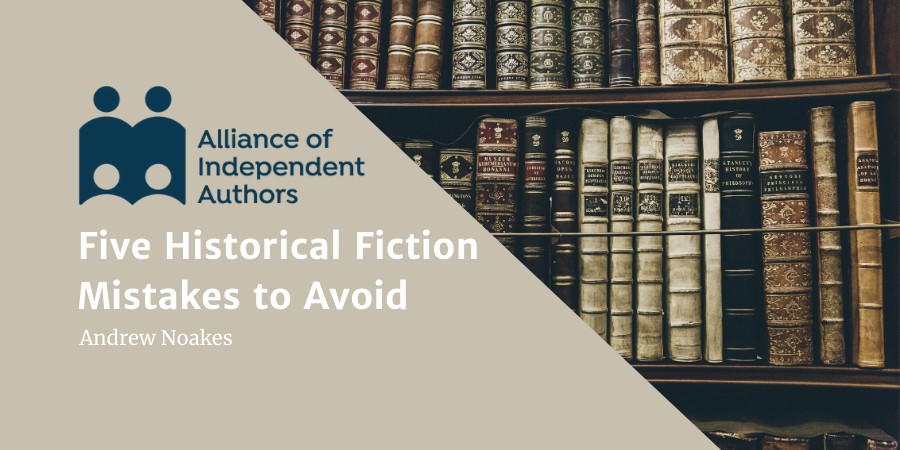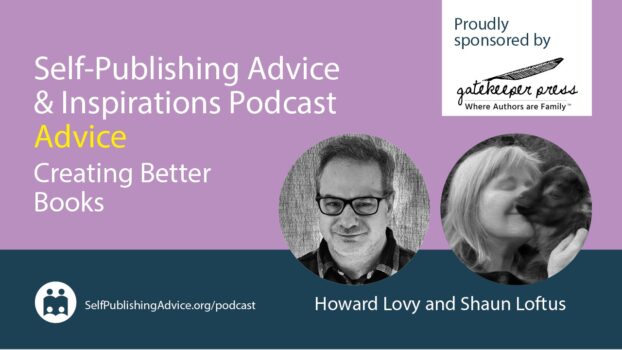The Alliance of Independent Authors has members writing in all sorts of genres. But today, Andrew Noakes, founder and executive editor of The History Quill is here to go niche. Andrew discusses historical fiction and the most common mistakes you should avoid when writing in the genre.
Five Historical Fiction Mistakes to Avoid
Writing historical fiction is most often a fascinating, inspiring, and invigorating process, but sometimes it can also feel like running a gauntlet. Nothing is more likely to strike terror into a historical fiction writer than the inescapable idea that something, somewhere in their manuscript may be historically inaccurate. But that’s not the only risk. As a specialist historical fiction editor, I’ve seen a whole range of mistakes common to the genre. Have no fear, though: below I have outlined the top 5 mistakes I encounter, complete with tips on how to avoid them.

Andrew Noakes, founder and executive editor of The History Quill.
Historical Fiction Mistakes: Too Much History, Not Enough Story
If you’ve spent months – often years – immersing yourself in your chosen historical period, researching everything from the prevalent fashions to how people went to the toilet, you’ll no doubt feel the overwhelming urge to share everything you know with your reader.
But give yourself a reality check.
In truth, 90 per cent of the details you unearth in the course of your historical research should never be used in your novel. If you ignore this, the history will end up drowning out the story. While historical fiction readers want to be immersed in an authentic historical world, remember that what they’re ultimately looking for is a story, not a history book. This means you must selectively deploy your knowledge rather than dumping everything you know onto the page.
One good way of dealing with this is to seamlessly integrate the history. For example, it’s better to show the reader what kind of weapons would have been used during your period in a battle scene that’s integral to the plot rather than by having your protagonist take a random trip to the armoury to inspect them.
Historical Fiction Mistakes: Getting the Small Details Wrong
While you shouldn’t overwhelm your reader with every imaginable detail about your period (see above), selective use of some of the small details of every-day life can really help to create a sense of authenticity. The problem is when writers get these details wrong.
We’ve all seen the kind of mistakes I mean. The protagonist of a Regency novel making their own introductions at a public ball rather than waiting to be introduced. Or people eating potatoes in Europe decades or centuries before they were first introduced. Errors such as these jar the reader out the story, making them feel as if the past is being carelessly and inaccurately rendered.
You need to get the small details right when they make an appearance. For this, do your research. We’re fortunate that some really useful books have been written on every-day life during different historical periods, from Lionel Casson’s Life in Ancient Rome to Toni Mount’s Everyday Life in Medieval London.
Primary sources can be useful too, particularly diaries and letters written by travellers or immigrants, who were more likely to find the ‘ordinary’ features of life noteworthy.
Historical Fiction Mistakes: Accuracy vs Authenticity
Historical fiction writers are, understandably, often very focused on historical accuracy. Most of the time, this is a good thing and helps to guard against mistakes. However, if they become too myopic or uncompromising, a different problem can develop: too much accuracy.
What? Too much accuracy? Yes, it is possible. Consider this:
Aleyn spak first, ‘al hayl, Symond, y-fayth;
How fares thy faire doghter and thy wyf?'
‘Aleyn! welcome,' quod Symond, ‘by my lyf,
And John also, how now, what do ye heer?'
This is how people spoke to each other in the late 14th century. Well, kind of. These lines of dialogue come from The Canterbury Tales, and they are a good example of Middle English.
Now, clearly, most readers wouldn’t want to read a historical novel where all the dialogue is written in Middle English. If you wrote such a book, you would be taking accuracy just too far. And yet readers don’t want your dialogue to sound modern, either.
The answer is a concept called historical authenticity, which often diverges from strict historical accuracy. It means creating the sense of accuracy without necessarily enforcing the full reality of it upon the reader.
This is particularly important when it comes to language. With historical dialogue, the trick is to avoid words and phrases that sound overly modern, focus on using neutral words that feel more or less at home both in the modern day and in earlier periods, and include a few archaic – yet still intelligible – words and phrases here and there to give the reader a good sense of the period.
Historical Fiction Mistakes: Historical Characters, Modern Mindsets
Ancient Romans thought it was fine to watch gladiators fight to the death, Europe’s role in the slave trade was considered morally acceptable by many at the time, and attitudes on race and gender have come a long way over just the last hundred years. In the past, people had different ingrained values, views, and norms. Many of them would be considered backwards today, and some of them downright odious.
So how do we create characters that are historically accurate while not alienating or frustrating modern readers? Sometimes, historical fiction writers go too far in one direction, either oversteering and making all of their characters unrealistically forward-thinking, or showing no sense of nuance or sensitivity in their depiction of these issues.
In navigating this question, the first thing to say it that not all historical people conformed to the predominant beliefs of their time. Though the slave trade may have been considered acceptable by many, a vocal lobby opposed it and eventually converted the majority to their cause. There were progressive voices in the past on issues of race and gender, just as there are now. You can legitimately go down the route of including characters whose opinions contradict the prevalent views of their time, or whose lives do not fit into the common mould, as long as there is a basis for it in history – and there often is. This is definitely one way out of the problem, as long as you don’t make every character unconventional and as long as your unconventional characters clearly appear unusual in your wider story world.
Of course, most people did still hold views and live lives that were typical for their time. My advice is to show sensitivity, think carefully about your use of language, and pick your battles. If you are respectful, nuanced in your approach, and have done your research, most readers will appreciate the authenticity of your portrayal.
Historical Fiction Mistakes: Bending the Truth too Much – or Not Enough
This is distinct from the accuracy and authenticity issues discussed above. Here, we’re talking about how to balance historical accuracy with creative license. This includes altering timelines, depicting real-life historical figures doing things they probably didn’t actually do, and throwing in some dramatic flourishes that may not strictly be rooted in fact, among other things.
There are as many opinions on this as there are historical fiction writers, so the first thing to recognise and accept is that, whatever you do, you’ll probably annoy someone. The most important thing you need to do is work out what your own rules are, then follow them. That being said, here is some general guidance that you should consider:
1) It’s a good idea to include a historical note at the end of your story explaining where you have deviated from history and why. This can help to disarm readers who have taken an exception to particular decisions.
2) History is open to interpretation, and even historians often disagree. Adopting legitimate interpretations based on recognised historical sources – even interpretations that diverge from the prevailing wisdom – is usually acceptable. There are also lots of gaps in the historical record, and it’s legitimate to fill those gaps with plausible interpretations of what might have happened.
3) If you’re going to alter a verifiable fact or invent something about a real figure, make sure you have a good reason, make sure the alteration is plausible, keep it to the necessary minimum, and be aware that the more verifiable something is and the more central to history it is (or the bigger the real-life figure), the more risky it is to change it.
Historical Fiction Mistakes: Don’t be too Hard on Yourself
This is my final piece of advice. It’s all too easy to get overwhelmed by the possibility of making one of these mistakes and let that sap your confidence and motivation. Don’t let it. Everyone makes mistakes; even books by bestselling authors contain errors. Be conscious of these pitfalls, yes, but most of all, enjoy the process of writing.
If you’re looking for more tips on writing historical fiction, check out The History Quill’s guide for beginners, How to write historical fiction in 10 steps, and our dedicated guide to accuracy and authenticity in historical fiction.
OVER TO YOU
What tips and tricks do you have for writing historical fiction?
If you enjoyed this post you might like these from the ALLi archive:





One gripe I have is the use of the term ok or okay in historical fiction.
OK was a term invented and used in the 19th century supposedly in the USA.
It’s a book binner when ever I come across this.
For instance two roman legionaries sparing . one falls over and the other helps him up and asks if he is OK.
I presume its a problem with self publishing as a good editor would pick this up.
OK seems to be cropping up in tv series such as britannia.
I am sure a young female druid apprentice would not ask her mentor if he was OK.
Another error I spotted concerns tree species having read a book on the roman invasion of britain mentioning sycamore which were introduced much later.
Thanks for these excellent comments. I think I stuck very close to all of them, but after your bit about language, I decided to go back and just slightly sorta kinda modernize a bit for readability. Thanks again.
Excellent post/article. A couple of times I have posted on my blog about mistakes in researching Biblical fiction. Many only go back to the Middle Ages when customs were vastly different from the 1st century AD, others seem to take their research from popular movies. Then others do incredible research and I thoroughly enjoy the book/series.
The point about too much research info is a good one, and I solved that by making the extra research available as handouts for my readers’ newsletter.
My ‘main’ series… the Apostle John Series, had a disclaimer that this was a ‘what if’ scenario, not a statement that John had a wife and family.
I loved all your points and have saved the post for future reference.
Thank you
I’ve only written one biographical historical novel–about the little sister of Henry VIII. It’s my bestseller by a wide margin. Trouble is, since writing that one, I’ve suffered a stroke and a broken hip, so the thought of attempting a second is daunting!
Where it can be difficult is remembering to keep names, personalities and descriptions consistent with the first book(s), I used Excel as a database for characters etc. I am now on home oxygen 24/7 and even so require regular hospitalisations. Not giving up, though I admit it is more difficult.
Try not to be daunted. Take a breather if you need to.
Susan
My worry about writing historical fiction is the legality surrounding writing about a deceased person (died in the 1980s) and the right of publicity. There’s a terrific story I’d like to write, but I’m worried about being sued by the person’s descendants (which is apparently allowed in some states like California). How in the world does anyone write historical fiction about more recent events and people without running into legal trouble?
Excellent points offered in a manner to inspire. Thank you.
This post was very interesting to me because this spring I’m publishing a novel on the fall of Communism in Prague – which I lived through. I’m including endnotes on a few changes in historical fact, as you suggest. I’m also using them in limited cases where an issue is so complex that doing it justice would threaten to overwhelm the story, the first danger that you discuss.
In addition, I’m including a few very carefully chosen photographs FOLLOWING each chapter. Images of some kind (painting, eg, for older history) could or could not be useful for other writers depending on a number of factors. (One, is finances, of course.) In my novel, one interest is how earlier movements and historical figures resurfaced in 1989, and I’m using the photos to evoke them, alongside limited text in the body of the novel. I would NOT want the images to interfere with the flow of the story, though.
Andrew, I am curious as to the best publicity avenues for historical – and especially modern – historical fiction. I should think that Amazon and other sellers would be a better investment that the traditional book trade. Could you comment ?